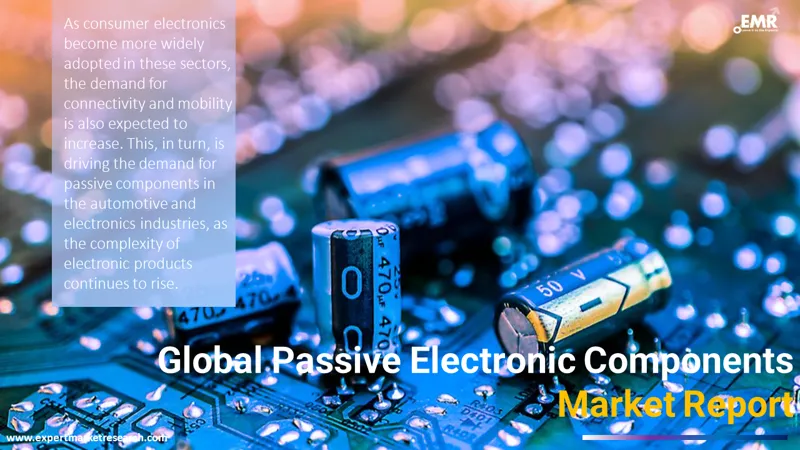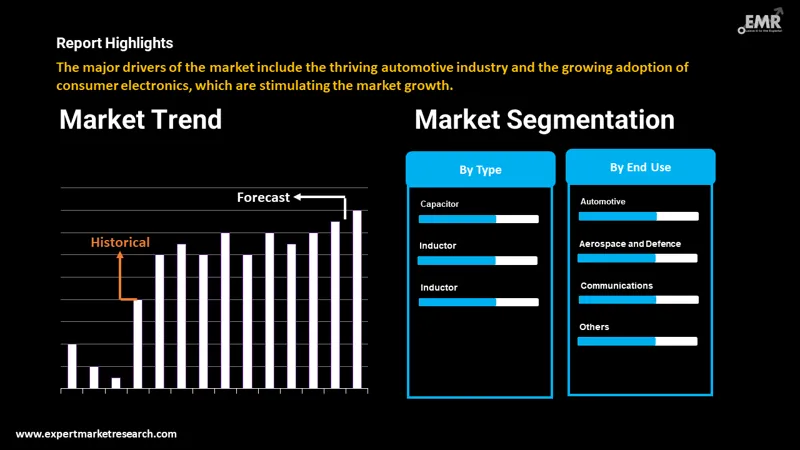
Consumer Insights
Uncover trends and behaviors shaping consumer choices today
Procurement Insights
Optimize your sourcing strategy with key market data
Industry Stats
Stay ahead with the latest trends and market analysis.
The passive electronic components market reached a value of about USD 37.13 Billion in 2025. The market is further expected to grow at a CAGR of about 4.80% in the forecast period of 2026-2035 to reach a value of around USD 59.34 Billion by 2035, owing to the growth in the automotive industry.
Base Year
Historical Period
Forecast Period
Compound Annual Growth Rate
4.8%
Value in USD Billion
2026-2035
*this image is indicative*
| Global Passive Electronic Components Market Report Summary | Description | Value |
| Base Year | USD Billion | 2025 |
| Historical Period | USD Billion | 2019-2025 |
| Forecast Period | USD Billion | 2026-2035 |
| Market Size 2025 | USD Billion | 37.13 |
| Market Size 2035 | USD Billion | 59.34 |
| CAGR 2019-2025 | Percentage | XX% |
| CAGR 2026-2035 | Percentage | 4.80% |
| CAGR 2026-2035 - Market by Region | Latin America | 5.2% |
| CAGR 2026-2035 - Market by Country | India | 5.4% |
| CAGR 2026-2035 - Market by Country | China | 5.1% |
| CAGR 2026-2035 - Market by End Use | Automotive | 5.5% |
| CAGR 2026-2035 - Market by Type | Capacitor | 5.7% |
| Market Share by Country 2025 | Germany | 4.7% |
The Asia Pacific region is a significant market for capacitors due to considerable growth in China and India. China's automotive industry is rapidly expanding, and the country is becoming increasingly important in the global automotive market. The government considers the automobile industry, especially the auto components sector, a core industry for the country. This is expected to accelerate the demand for capacitors in the forecast period, propelling the passive electronic components market growth. The expanding electronics industry is driving several multinational corporations to establish production operations in Asian countries, independently or through joint ventures with other regional enterprises. This includes large global organisations such as Tyco Electronics, FCI OEN, Vishay, and EPCOS. This is further anticipated to drive the local manufacturing activity of resistors in Asia Pacific. The Asia Pacific region has the highest demand for inductors, with numerous countries such as Japan, China, South Korea, and Taiwan holding enormous factories and foundries for several key passive electronic powerhouses. Due to its fast-increasing semiconductor industry and industrial automation, China is one of the largest sources of demand for inductor components in the current market scenario. Such factors are anticipated to augment the market for passive electronic components in Asia Pacific.

Read more about this report - REQUEST FREE SAMPLE COPY IN PDF
Significant growth in the automotive industry across the globe is expected to create a positive outlook for the market. Passive electronic components are widely used in specialised and high-performing components, such as emergency brake assistance systems and infotainment. Consequently, the rising demand for electric cars (EVs) due to environmental and pollution concerns is propelling the market growth. The increased use of hybrids and electric vehicles (EVs) is significantly reducing the environmental load and increasing the number of electronic control units (ECUs), resulting in increased demand for electronic components, whose miniaturisation and performance improvements have been increasing. The demand for electronic components in automotive applications is driven by new automotive features and functionality such as autonomous vehicle technologies, vehicle-to-vehicle (V2V) communications, advanced driver-assistance systems (ADAS), and other safety and sensing systems such as backup cameras and lane-departure detectors. Passive components such as capacitors are necessary to ensure design stability and interference-free operation.

Read more about this report - REQUEST FREE SAMPLE COPY IN PDF
Passive electronic components are electrical parts that do not generate electricity and cannot gain power. They consist of resistors, capacitors, transformers, inductors, and coils. Tantalum, ceramic, aluminium electrolytic, paper, and plastic films are used in their production. These components absorb energy and do not need electricity to function. They are dependable, simple to design, inexpensive, and capable of handling high voltage currents and power without needing a power source or amplifying elements.
Market Breakup by Type
Market Breakup by End Use
Market Breakup by Region
| CAGR 2026-2035 - Market by | Country |
| India | 5.4% |
| China | 5.1% |
| Mexico | 5.0% |
| UK | 4.9% |
| USA | 4.8% |
| Canada | XX% |
| Germany | 4.4% |
| France | XX% |
| Italy | XX% |
| Japan | XX% |
| Australia | XX% |
| Brazil | XX% |
| Saudi Arabia | 4.4% |
The passive electronic components market is expected to grow significantly during the forecast period, owing primarily to the increasing digitalisation of various sectors. This will result in increased adoption of consumer electronics across these sectors and increased demand for connectivity and mobility. With these advancements, the complexity of electronic products is also increasing. This is accelerating the demand for passive components in the electronics and automotive industries. The increasing number of product launches, innovations in the consumer electronics sector, the expanding use of inductors in automotive electronics, and the increasing acceptance of smart grids are also contributing to the continuous rise of inductors. The key element driving demand for inductors is the increased need for consumer electronics, such as smartphones, tablets, laptops, set-top boxes, and portable gaming consoles. Apart from this, the increasing use of inductors in medical devices linked with sensors to collect data about patients, significant research and development (RD&D), and the introduction of diverse shapes and geometries of inductors are expected to propel the market forward.
The report gives a detailed analysis of the following key players in the global passive electronic components market, covering their competitive landscape, capacity, and latest developments like mergers, acquisitions, and investments, expansions of capacity, and plant turnarounds:
The comprehensive EMR report provides an in-depth assessment of the market based on the Porter's five forces model along with giving a SWOT analysis.




*While we strive to always give you current and accurate information, the numbers depicted on the website are indicative and may differ from the actual numbers in the main report. At Expert Market Research, we aim to bring you the latest insights and trends in the market. Using our analyses and forecasts, stakeholders can understand the market dynamics, navigate challenges, and capitalize on opportunities to make data-driven strategic decisions.*
Get in touch with us for a customized solution tailored to your unique requirements and save upto 35%!
In 2025, the global passive electronic components market attained a value of nearly USD 37.13 Billion
.
The market is projected to grow at a CAGR of 4.80% between 2026 and 2035.
The market is estimated to witness a healthy growth in the forecast period of 2026-2035 to reach USD 59.34 Billion by 2035.
The major drivers of the market include the increasing digitalisation of various sectors, increasing number of product launches, expanding use of inductors in automotive electronics, increasing acceptance of smart grids, increasing use of inductors in medical devices, and introduction of diverse shapes and geometries of inductors.
Significant growth in the automotive industry and increased adoption of consumer electronics are the key industry trends propelling the growth of the market.
The major regions in the industry are North America, Latin America, the Middle East and Africa, Europe, and the Asia Pacific.
Based on type, the market is divided into capacitors, inductors, and resistors. The capacitor is further divided into ceramic capacitors, tantalum capacitors, aluminium electrolytic capacitors, paper and plastic film capacitors, and supercapacitors, while the inductor is sub-divided into power and frequency. The resistor is broken down into surface-mounted chips, network, wire wound, film/oxide/foil, and carbon.
The end-uses of the market are automotive, consumer electronics and computing, aerospace and defence, and communications, among others.
The major players in the industry are YAGEO Group, TDK Corporation, KYOCERA Corporation, Murata Manufacturing Co., Ltd.", Ohmite Mfg Co., Nippon Chemi-Con Corporation, and WIMA GmbH & Co. KG, among others.
Explore our key highlights of the report and gain a concise overview of key findings, trends, and actionable insights that will empower your strategic decisions.
| REPORT FEATURES | DETAILS |
| Base Year | 2025 |
| Historical Period | 2019-2025 |
| Forecast Period | 2026-2035 |
| Scope of the Report |
Historical and Forecast Trends, Industry Drivers and Constraints, Historical and Forecast Market Analysis by Segment:
|
| Breakup by Type |
|
| Breakup by End Use |
|
| Breakup by Region |
|
| Market Dynamics |
|
| Competitive Landscape |
|
| Companies Covered |
|
| Report Price and Purchase Option | Explore our purchase options that are best suited to your resources and industry needs. |
| Delivery Format | Delivered as an attached PDF and Excel through email, with an option of receiving an editable PPT, according to the purchase option. |
Datasheet
One User
USD 2,499
USD 2,249
tax inclusive*
Single User License
One User
USD 3,999
USD 3,599
tax inclusive*
Five User License
Five User
USD 4,999
USD 4,249
tax inclusive*
Corporate License
Unlimited Users
USD 5,999
USD 5,099
tax inclusive*
*Please note that the prices mentioned below are starting prices for each bundle type. Kindly contact our team for further details.*
Flash Bundle
Small Business Bundle
Growth Bundle
Enterprise Bundle
*Please note that the prices mentioned below are starting prices for each bundle type. Kindly contact our team for further details.*
Flash Bundle
Number of Reports: 3
20%
tax inclusive*
Small Business Bundle
Number of Reports: 5
25%
tax inclusive*
Growth Bundle
Number of Reports: 8
30%
tax inclusive*
Enterprise Bundle
Number of Reports: 10
35%
tax inclusive*
How To Order

Select License Type
Choose the right license for your needs and access rights.

Click on ‘Buy Now’
Add the report to your cart with one click and proceed to register.

Select Mode of Payment
Choose a payment option for a secure checkout. You will be redirected accordingly.
Gain insights to stay ahead and seize opportunities.

Get insights & trends for a competitive edge.

Track prices with detailed trend reports.

Analyse trade data for supply chain insights.

Leverage cost reports for smart savings

Enhance supply chain with partnerships.

Connect For More Information
Our expert team of analysts will offer full support and resolve any queries regarding the report, before and after the purchase.
Our expert team of analysts will offer full support and resolve any queries regarding the report, before and after the purchase.
We employ meticulous research methods, blending advanced analytics and expert insights to deliver accurate, actionable industry intelligence, staying ahead of competitors.
Our skilled analysts offer unparalleled competitive advantage with detailed insights on current and emerging markets, ensuring your strategic edge.
We offer an in-depth yet simplified presentation of industry insights and analysis to meet your specific requirements effectively.
Share